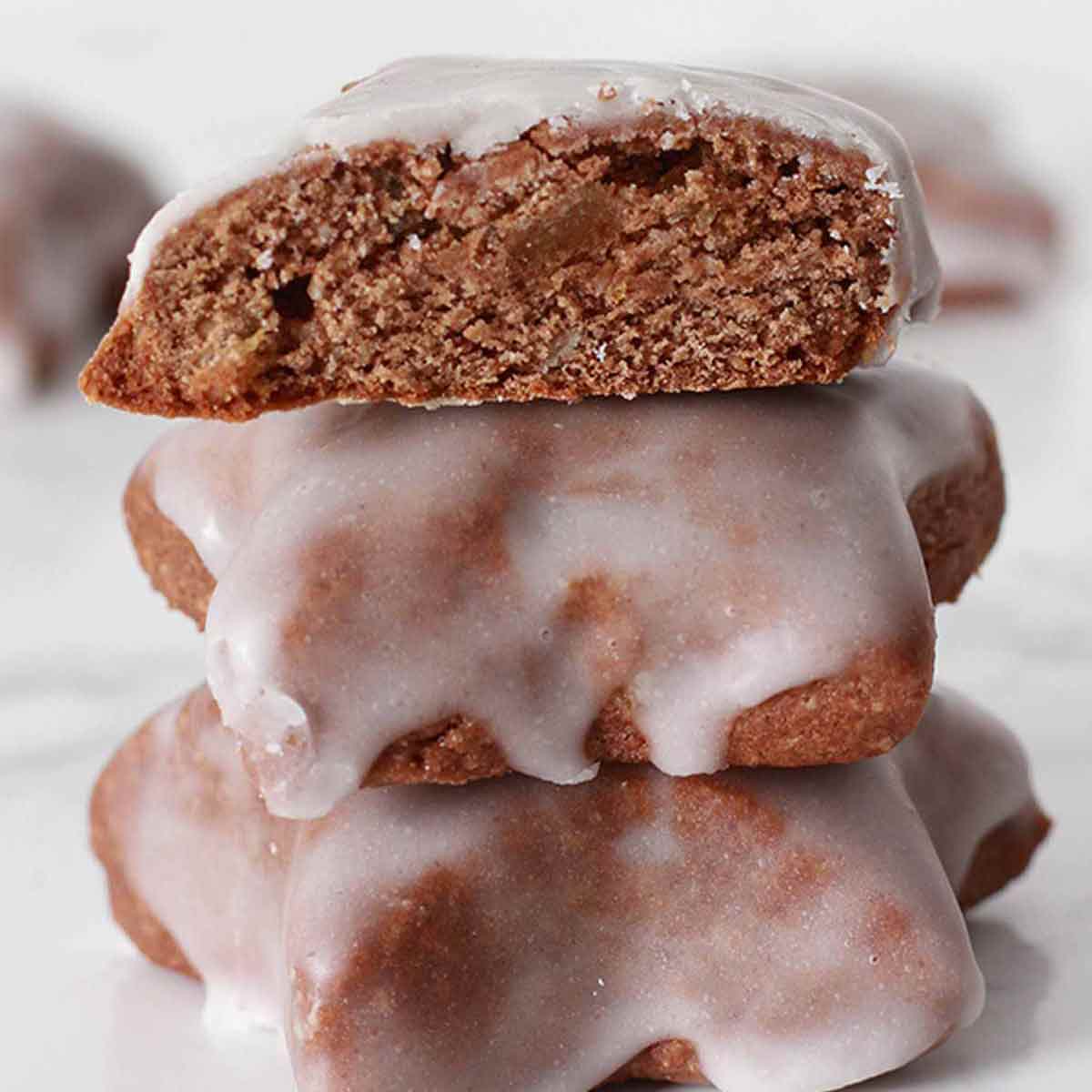Vegan Lebkuchen
Easy vegan lebkuchen cookies covered in a lemon glaze. These are traditional German Christmas cookies, similar to gingerbread, but are soft and cakey in texture. They’re made with brown sugar, warming spices, cocoa powder and citrus peel. Make a batch of these if you fancy something a little different this Christmas!

It’s been a long time coming but I finally carved out time to perfect my lebkuchen recipe.
Well, when I say perfect, I mean that I’ve perfected it to the best of my knowledge! Since I’m not German, I can’t guarantee that these are 100% authentic lebkuchen, but they taste identical to the ones I’ve tried before.
There are a few different types of lebkuchen available to buy from supermarkets here in the UK. Some are covered in chocolate, some are glazed, and some are made in the traditional way with the wafers at the bottom.
I recently tried Tesco’s lebkuchen hearts, which are covered in chocolate and have an apricot filling. It just so happens that they’re accidentally vegan and extremely delicious! However, their glazed lebkuchen are not suitable for vegans, and those are the ones that I wanted to try the most, so I decided I’d make my own.
Are lebkuchen cookies vegan?
Lebkuchen cookies are usually made with eggs, dairy and honey which means that they’re not vegan. However, there are a few exceptions and sometimes you’ll find ‘accidentally vegan’ lebkuchen like the ones I mentioned above. I know that Aldi also sell them in the UK but to be honest, these homemade ones taste much better!
To make dairy-free lebkuchen, I took a look at a number of non-vegan recipes on the web, to get an idea of the quantities of each ingredient. I then wrote up a few vegan recipes (guesses) to test out, omitting the dairy and eggs, using agave instead of honey, and adding some plant-based milk for extra moisture. It took a fair few tries and tweaks before I finally got my vegan version to taste the way I wanted it to, but we got there in the end!
More vegan Christmas cookies:
How to make vegan lebkuchen
Step 1:
This recipe looks complicated because it has a large amount of ingredients but I promise you, it’s super easy! The first step is to mix together your ‘wet’ ingredients.
In a large bowl, mix together 150g of soft brown sugar, 50g of softened vegan butter, 150g of agave nectar, 1 teaspoon of vanilla extract and 4 tablespoons of soy milk. The mixture will look curdled but don’t worry! The dry ingredients will sort that out.

Note: It’s important that you use a block butter for this recipe and not the soft, spreadable, margarine type of vegan ‘butter’. The latter has a higher water content and therefore will not work the same in this recipe. I recommend Stork baking block.
I used soy milk because it’s what I always use for baking. But because it’s mainly used for moisture in this recipe, I think other plant-based milks like oat or almond would work just fine.
Step 2:
In a separate bowl, mix together your dry ingredients. Alternatively, you can add them to the wet ingredients using a sieve, which will help to mix them up.
Add 220g of plain (all-purpose) flour, 130g of ground almonds, 2 tablespoons of cocoa powder, 1/2 teaspoon of baking powder, 2 teaspoons of ground ginger, 1/2 teaspoon ground cinnamon, 1/4 teaspoon of all spice (can be subbed for mixed spice), and 1/4 teaspoon of nutmeg.
Mix it into the wet mixture until it comes together in a loose ball. The dough will be super sticky!

Step 3:
Add 2 tablespoons of candied mixed peel to the dough and mix it in using a spatula or wooden spoon. I used Tesco mixed peel but you can substitute this for orange and/or lemon zest if you prefer.
Step 4:
Place the sticky dough into the fridge for around 30 minutes. This will help it to firm up slightly, and will prevent the cookies from spreading too much while baking.
Traditionally, the dough is left covered at room temperature for 24 hours to let the flavours really come through. I haven’t tried this yet but let me know if you do!
Step 5:
While the dough is chilling, preheat your oven to 170°C/340°F (or 150°C/300°F if you’re using a fan or convection oven). Line a large tray with baking paper.
Step 6:
When the 30 minutes are up, remove the dough from the fridge (it will still be sticky). Take 2 tablespoons of dough (around 50g) and roll into a ball. Place onto your baking tray and flatten slightly with your fingers. It should be around 1+1/2 inches thick.
Repeat until all of the dough has been used up. You should end up with around 16-18 cookies.

If you want to cut shapes for lebkuchen hearts or stars, roll out small balls of dough on a heavily floured surface, using a floured rolling pin and a floured 3-inch cookie cutter. Don’t roll the dough too thin- around 1-inch is perfect.
Note: Do not try to roll out the whole batch of dough because it will be far too sticky! Likewise, do not add more flour to the dough to make it less sticky as this will make the cookies too crunchy once baked.
Step 7:
Bake your cookies for around 18-20 minutes. Smaller shapes will need less time. You’ll know they’re done when they no longer sink when gently pressed.

Leave the cookies on the tray until completely cool.
For the lemon glaze
To make the glaze, mix together 180g of icing sugar with 2 tablespoons of fresh lemon juice and 1 tablespoon of water. You should end up with a smooth, runny icing.
Dunk your dairy-free lebkuchen into the icing and rotate a few times to let the excess come off. Place them onto a wire rack with baking paper underneath to catch excess glaze. Let them sit at room temperature for an hour or so, until the glaze has fully set.
Top tips
- Use a vegan block butter over dairy-free margarine.
- Swap the mixed peel for lemon or orange zest if desired.
- Use rum instead of lemon juice for a more intense, festive flavour.
- Coat the lebkuchen in dark chocolate if you don’t want the cookies to be too sweet.
FAQ:
Keep them in an airtight container in a cool, dry place. They’ll last for over a week this way.
Yes. Pop them into a ziplock bag or an airtight container and freeze for up to 3 months. When you’re ready to eat them, transfer them to a wire rack or plate and let them sit at room temperature until fully thawed.


Vegan Lebkuchen (Dairy-Free German Christmas Cookies)
Easy, cakey lebkuchen without eggs or dairy.
Ingredients
- 150 g Soft brown sugar (¾ cup)
- 50 g Vegan block butter (3 tablespoons + 1 teaspoon)
- 150 g Agave nectar (~7+½ Tablespoons)
- 60 ml Soy milk (4 tablespoons)
- 1 Teaspoon Vanilla extract
- 220 g Plain flour (1+¾ cup)
- 130 g Ground almonds (1+⅓ cup)
- ½ Teaspoon Baking powder
- 2 Tablespoons Cocoa powder
- 2 Teaspoons Ground ginger
- ½ Teaspoon Ground cinnamon
- ¼ Teaspoon All spice (can be subbed for mixed spice)
- ¼ Teaspoon Ground nutmeg
- 2 Tablespoons Candied mixed peel (sub for lemon and/or orange zest)
For the lemon glaze:
- 180 g Icing sugar (1 cup + 3 tablespoons)
- 2 Tablespoons Lemon juice
- 1 Tablespoon Cold water
Instructions
-
In a large bowl, mix together the sugar, butter, agave nectar, vanilla extract and soy milk. It will look curdled once mixed but don't worry!
-
Add the rest of the ingredients to the bowl, except the mixed peel. Mix well until it comes together. It will be a very sticky dough.
-
Stir in the mixed peel then place the dough in the fridge for 30 minutes.
-
In the meantime, preheat your oven to 170°C/340°F (or 150°C/300°F if you're using a fan or convection oven). Line a large tray with baking paper.
-
After the 30 minutes are up, remove the dough from the fridge. Take around 2 tablespoons of dough at a time and roll into balls. Place the balls onto your lined baking tray and gently press them until they're around 1+½ inches thick. Don't flatten them too much or they'll be too crunchy after baking.
-
Bake for 18-20 minutes, or until you can gently press on the tops of the cookies without them sinking. Leave them to cool completely on the tray.
For the glaze:
-
Mix the icing sugar, lemon juice and water together to make a smooth, runny glaze.
-
Dunk the cooled cookies into the glaze and let the excess drip off. Place them on a wire rack with baking paper underneath and let them sit at room temperature until the glaze has hardened.
Recipe Notes
- If making lebkuchen hearts or stars, roll small pieces of dough at a time to around 1-inch thick. Do not try to roll the whole batch of dough out! Because the dough is so sticky, you’ll need to do this on a heavily floured surface, and use a floured rolling pin and floured cutter. Do not add extra flour to the dough itself as this will spoil the soft, cakey texture.
- Coat the lebkuchen in dark chocolate if you prefer a not-so-sweet cookie.




Kim
Monday 8th of January 2024
These are PHENOMENAL! I was so surprised that they tasted exactly like I want my lebkuchen to taste. Perfectly cakey, spiced, and delicious. (I did replace the candied peel with candied ginger, and replaced the lemon in the glaze with pineapple juice since I am allergic to citrus). These will become a staple in my house!
Chloe
Thursday 11th of January 2024
Thank you so much Kim!
Suri
Wednesday 20th of December 2023
I made these with my boyfriend who is German...they were delicious! So much so that I'm about to make another couple of batches to share with my friends and family. We used the zest of one lemon instead of candied mixed peel and it did the trick. So much better than shop bought ones and easy to make. Thank you for sharing this recipe!
Chloe
Wednesday 20th of December 2023
Hi Suri, thanks for your comment. I'm so happy you liked the cookies!
Nicola
Wednesday 21st of December 2022
Reminds me so much of the Christmas market lebkuchen here and I'm so pleased that it's vegan. Thank you for providing the recipe😊
Chloe
Wednesday 21st of December 2022
Thank you so much for your review Nicola! So glad you liked the recipe :)
Chloe
Thursday 15th of December 2022
Oh thank you so much for letting me know! I will update the post :)
Lorelei
Sunday 4th of December 2022
I baked these yesterday and they were so good! Thank you so much for providing this recipe
Chloe
Sunday 4th of December 2022
Thanks so much for your review:) So glad you liked them!